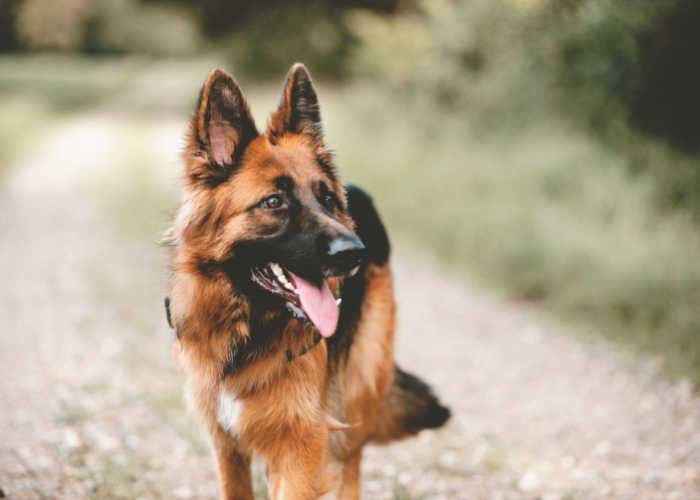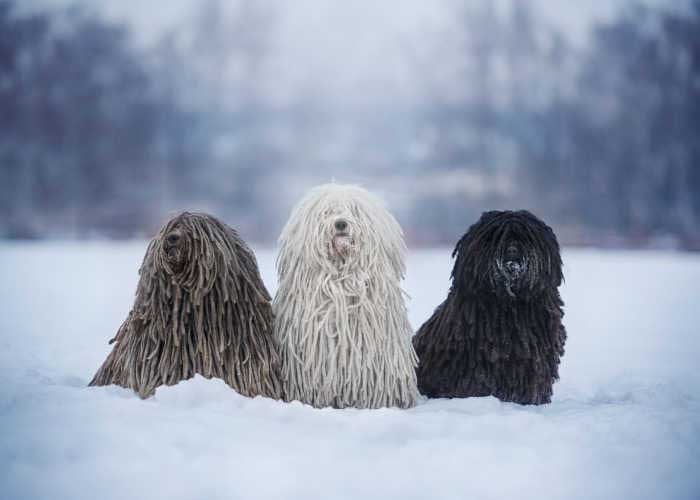10 Best Pastoral Dog Breeds – Top Dog Tips
Out of the 222 dog breeds recognized by The Kennel Club, can you tell which of those are pastoral dog breeds?
A canine originally raised for herding or protecting animals on farms, such as cattle, sheep, and reindeer is referred to as a pastoral dog.
This breed of dog is listed in the Pastoral Group section of The Kennel Club’s (UK) breed registries.
While some kennel associations refer to such dogs as herding dogs, others include them in the working group.
The Pastoral Group is quite new in The Kennel Club classifications, with most of its members formerly belonging to the Working Group.
It wasn’t until the Working Group grew to be too big that it was established as a separate dog group.
Pastoral breeds respond well to training and usually develop close bonds with their handlers. They are good at obeying orders but are also capable of using their judgment.
In this article, learn about the most common pastoral dog breeds and their traits to see if they would make a wonderful addition to your family!
Getting to Know Pastoral Dog Breeds
Based on their respective roles, the Pastoral Group is divided into two smaller groups:
Livestock Guardians
Livestock guardian dogs protect the flock from predators such as foxes and wolves.
As full-time members of the herd, they live with the animals they guard. Because of their early attachment to the herd, these dogs’ ability to protect the pack is mainly instinctive.
Livestock guardian dogs blend in with the flock, keeping an eye out for intruders, as opposed to herding dogs, which control the movement of livestock.
Their presence is usually enough to ward off some predators, intimidating them by barking and acting aggressively. If a predator cannot be driven away, the dog may attack or fight with it.
Herding Breeds
To control other animals, these dogs use different methods.
Some breeds are known as heelers or driving dogs because they nip at the animals’ heels to keep them moving. Usually, they stay behind the herd.
Others get in front of the flock and use what is referred to as a “strong eye” to stare them down. They are known as fetching dogs or headers that keep the animals together.
While certain dogs have traditionally been used as tending dogs, acting as a “living fence” to prevent the flock from eating valuable crops or getting lost on roads, some breeds use their loud, powerful bark to call in flocks of sheep.
Top 10 Pastoral Dog Breeds
Pastoral dog breeds vary in almost every size and coat type, from the small heelers to the giant breeds that serve both as guardians and herders, requiring their size and strength.
Let’s take a look at these popular pastoral breeds in more detail.
Anatolian Shepherd Dog
- Height: 27 – 29 inches
- Weight: 80 – 150 pounds
- Life Expectancy: 11 – 13 years
The Anatolian Shepherd Dog is a native of Turkey, where they were raised as a shepherd’s companion and livestock protector.
Together with their master, they lived a nomadic life while traveling great distances across the Central Anatolian Plateau.
To blend in with the flock and avoid being seen by predators, they were designed with particular characteristics to look like the size and color of the animals they protected.
Rugged and confident, these flock guards know how much intimidation or protection is necessary for any situation.
This breed developed the physical attributes necessary to survive since it spent its whole life outdoors, through bitterly cold winters and extremely scorching summers.
In general, Anatolians get along well with and are tolerant of older kids. Children, like the rest of the family, are a part of the flock that needs to be protected.
Although Anatolians gained popularity as family pets, novice owners should look elsewhere because of the breed’s brazen personality and enormous size.
They will literally and figuratively walk all over an unprepared owner.
Border Collie
- Height: 18 – 22 inches
- Weight: 30 – 55 pounds
- Life Expectancy: 12 – 15 years
In the rugged border region between Scotland and England, the Border Collie was created to herd and control sheep.
They are renowned for their “eye,” or fierce gaze, which they use to command their flock.
Border Collies are still used to herd sheep on farms and ranches all over the world because of their energy, endurance, and hard work. Anyone would have to agree that they’re the best breed for this job.
Exceptionally bright and trainable, these dogs perform exceptionally well in sports, including agility, flyball, obedience, tracking, and flying disc competitions.
They are happiest when living with a very active owner, perhaps one who is looking for a running partner.
This could be the perfect dog for you if you’re looking for a playful, brainy dog that will keep you on your toes.
Cardigan Welsh Corgi
- Height: 10.5 – 12.5 inches
- Weight: 25 – 38 pounds
- Life Expectancy: 12 – 15 years
The Cardigan Welsh Corgi is a native of the UK and was once classified as the same breed as the Pembroke Welsh Corgi breed.
It was claimed that their ancestors arrived in the UK as part of the Celt migration from central Europe.
The word “corgi” is thought to be a translation of the Welsh word “cor gi.” This actually meant “dwarf dog.”
This pup is a member of the Teckel family of short-legged hounds, which also includes the Dachshund. Farmers in Wales saw the Cardigan Welsh Corgi as a valuable asset since they used them as livestock keepers and herders.
Both the Cardie and the Pembroke are heelers. In other words, they nip at the heels of the sheep and cattle they are moving.
The only dog known to have been bred in Bronant, a village in the county of Ceredigion, was the Cardigan Welsh corgi.
Cardiganshire was the previous name of this county, where the breed got a portion of its name.
Although a capable guard dog, this hound wasn’t actually a “herding” dog because its skill was more for gathering a herd than for driving it. As a result, it served more as a “fence.”
Estrela Mountain Dog
- Height: 24.5 – 29 inches
- Weight: 77 – 132 pounds
- Life Expectancy: 10 – 14 years
Other names for the Estrela Mountain Dog are Portuguese Shepherd and Cao da Serra da Estrela.
Although they are widespread, these big, stunning dogs are predominantly found in Portugal, their country of origin.
Bred to guard sheep and goats in the Estrela Mountains of northern Portugal, this dog’s origins are unclear but were possibly developed with some Mastiff influence due to its strong build.
Any predator will find the Estrela Mountain Dog to be a dangerous opponent. It makes an exceptional watchdog because it is fearless but calm and will not hesitate to respond to danger.
The Estrela Mountain Dog still adheres to its guardian heritage today. It continues to be a working dog, protecting flocks in both its homeland and elsewhere.
They are even used as patrol dogs by the Portuguese Marines.
It also makes a great family companion since it has the intelligence, devotion, vigilance, and innate desire to care for the young that it requires in its early years.
Finnish Lapphund
- Height: 16 – 21 inches
- Weight: 33 – 53 pounds
- Life Expectancy: 12 – 15 years
Friendly and compassionate, Finnish Lapphunds are affectionate family dogs who love company.
The wolf-faced charmers, who were once reindeer herders for the local Sami tribes living north of the Arctic Circle, are suited to cold climates.
They have gorgeous, thick double coats that need frequent grooming, especially during the shedding season.
Lappies are medium in size, but because they were born and raised in the vast outdoors, they are less fit to live in apartments and other tight spaces.
Despite being one of Finland’s most popular dog breeds, these loving companions aren’t yet widespread family pets in the United States.
The breed makes a great outdoor companion. It will gladly go on walks or runs with people because it is active, has a waterproof coat, and can withstand the cold quite well.
Families with young kids might consider “Lappies.” This pooch adapts well to family life and is responsive to children.
It even has a gentle nature with the elderly and people with disabilities.
German Shepherd Dog
- Height: 22 – 26 inches
- Weight: 50 – 90 pounds
- Life Expectancy: 7 – 10 years
Though the German Shepherd‘s ancestors were herding dogs, they were raised to be the ideal working dogs, with the intention of creating a breed for the military and police forces.
German Shepherds played a significant role during both world wars as messengers, search and rescue dogs, supply carriers, and sentries.
Today, German Shepherds are becoming the most popular K-9 police and military officers all over the world.
Raised specifically for their intellect and power, they can learn new tasks fast and grasp instructions better than other breeds.
Brave and confident, it’s no surprise German Shepherds are among the most popular dog breeds in America.
These dogs are fiercely loyal and protective of their humans but are wary of strangers.
Originally bred with a strong work ethic, the average owner doesn’t need to be on the front lines to keep a German Shepherd happy.
This doggo makes a great companion for an active owner who likes to spend hours at the park or afternoons on the trail, thanks to their calm demeanor.
Hungarian Puli
- Height: 16 – 17 inches
- Weight: 25 – 35 pounds
- Life Expectancy: 10 – 15 years
As the name implies, Hungary is where the Hungarian Puli came from. It is an ancient sheepdog whose true ancestry is unknown.
Its ancestors are thought to have lived more than 6,000 years ago. Others claim that in the ninth century, the Magyars brought to Hungary canines with a similar appearance that were regarded as herding and guard dogs.
The origin of this breed of dog is likewise said to have been in Asia before spreading to other regions of the globe.
When it first came to Hungary, the Puli worked with the Komondor, a much larger livestock guardian dog, to herd animals across challenging terrain.
The two teamed up to chase away wolves and other predators.
As a herding and guard dog, this breed is naturally hard-working and protective. It is easy to train due to his desire to please.
Affection is something that the Hungarian Puli enjoys giving and receiving equally. While he loves his entire family, he often develops a close relationship with one particular family member.
Komondor
- Height: 25.5 – 27.5 minimum inches
- Weight: 80 – 100 pounds or more
- Life Expectancy: 10 – 12 years
The Komondor was made specifically to protect livestock. It was raised to think, act, and make decisions on its own.
Like most livestock-guarding dogs, they have a calm temperament. But when there is trouble, the dog will bravely defend its charges.
It is a large, powerful dog breed, armored with a thick coat that resembles a sheep’s, allowing it to blend in with the flock and hide, giving it the upper hand when predators attack.
Komondors are gentle and loyal when it comes to their family and friends. They naturally have a strong need to safeguard their loved ones, their home, and their belongings.
They can also be accepting of strangers if it is clear that their presence won’t cause any harm.
Norwegian Buhund
- Height: 16 – 18.5 inches
- Weight: 26 – 40 pounds
- Life Expectancy: 12 – 15 years
Also known as the Norwegian Sheepdog and Nordiske Sitz-hunde, the Norwegian Buhund is a herding dog originally from Norway.
It has long been used as a farm laborer, herder, and protector of flocks and families.
Among the Spitz breeds, the Norwegian Sheepdog is unique in having the desire to please people. With its intelligence and independence, you get a highly trainable and competent dog.
It is capable of handling a variety of tasks, including working as a police dog and competing in agility and obedience trials.
Although probably too friendly to actually pose a threat, it makes an effective watchdog due to its vigilant behavior and tendency to bark.
This breed, which some people describe as tirelessly energetic, requires a lot of daily intense exercise and playtime.
They are quite affectionate with their family, especially the children, and enjoy both a romp in the park and a snuggle on the couch.
Old English Sheepdog
- Height: 21 – 22 inches and up
- Weight: 60 – 100 pounds
- Life Expectancy: 10 – 12 years
Large and active, the Old English Sheepdog is easily recognizable by its distinctive shaggy coat.
The OES, as enthusiasts call the breed for short, was historically a drover, assisting farmers in transporting livestock to markets.
This pooch now lives comfortably at home but still participates in conformation, obedience, agility, and herding trials. It is a versatile, intelligent dog with a laid-back personality.
Despite being large dogs, Old English Sheepdogs can live in apartments as long as they get enough activity through walks and playtime.
This breed might be what you’re searching for if you want a loving, caring, and loyal family member!
Is it the Right Breed for You?
Pastoral dogs are constantly active and on the go.
Among all dog breeds, pastoral dogs are some of the most active.
They require high levels of exercise because they are quite energetic. This means that pastoral dogs won’t be the most soothing buddies for couch potatoes since they are always on the go!
They thrive in human company.
Pastoral dog breeds love to work closely with their beloved owners.
You can count on them to be confident and independent enough to take the initiative. Remember that separation-related behaviors are common because they need to cooperate closely with their human.
Pastoral breeds are strong-willed and tough.
Because their primary responsibility has always been caring for sheep, goats, or cattle, their personality has developed to portray a robust character that can withstand the weather.
Because they mastered moving even the most difficult livestock, pastoral breeds can therefore be stubborn. They won’t even mind taking you for a stroll in any weather!
They are eager to please, which makes training easy.
Pastoral dog breeds need to be able to move their livestock without harming them, no matter how challenging the task may be.
They are fairly adept at controlling their instincts, which is evident whenever you try to teach them a new trick.
Due to their ease of training, these dogs will pick up new skills quickly and readily. This makes them the highlight of any training session or canine competition.
Pastoral dog breeds thrive on interactive play and canine enrichment.
Members of the Pastoral Group require mental stimulation just as much as physical stimulation.
Thus, dog activities that allow them to collaborate with their humans are their concept of happiness.
Because of their intellect, they are often the most gratifying dogs to teach since they can easily stand out in their training class.
FAQs about Pastoral Dog Breeds
What is the purpose of pastoral dog breeds?
Dogs that were bred for herding and working with livestock on farms are generally known as pastoral breeds.
They are sturdy dogs that adapt well to the outdoors in all types of weather and love nothing more than having a job to do.
Which dog breeds are in the pastoral group?
The Kennel Club recognizes the following breeds in addition to those stated above as members of the Pastoral Group:
What defines a pastoral dog breed?
Pastoral dogs require constant activity since they have a lot of energy.
They are intelligent canines that enjoy learning new things. These doggos are naturally good at herding other animals–and even people!
Pastoral Dog Breeds: Final Thoughts
Pastoral dog breeds love working with their humans. Whenever the whole family is involved, whether it’s playtime or training, they will wag their tails with delight.
Given their skills in moving and defending livestock, it’s no wonder that pastoral dogs can quickly establish themselves as dependable members of the family who are always willing to assist but also quite enthusiastic about getting lots of exercise.
If you’re looking for a brave, smart pooch that will naturally create a deep bond with you, then choosing from the Pastoral Dog Group will be worth taking into consideration.
READ NEXT: 10 Best Utility Dog Breeds














